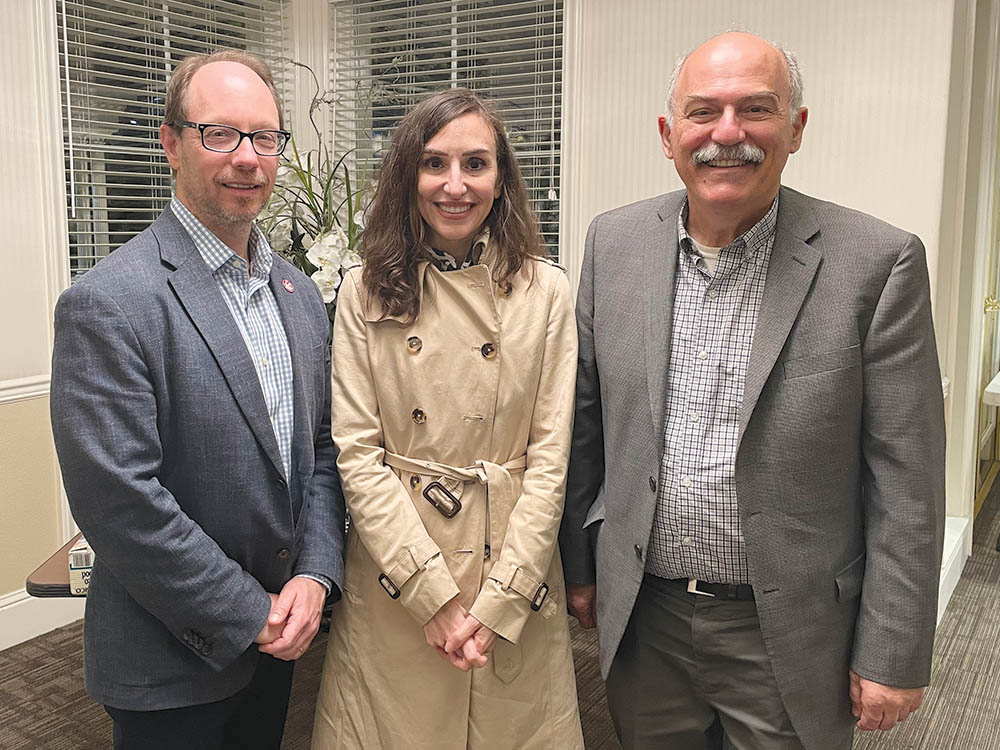
Photo: Andrew Hagopian
Staff Report
Dr. Christina Maranci, Mashtots Chair of Armenian Studies at Harvard University, gave the inaugural Grace and Paul Shahinian Armenian Christian Art Series on Saturday, April 15, 2023, at Fresno State. Her talk was on “Armenia Art: Current Directions and Future Goals” and was held at the Smittcamp Alumni House on the Fresno State campus. A reception took place immediately before the lecture.
In her illustrated lecture Dr. Maranci gave an overview of under-studied forms of Armenian art and discussed the major sub-disciplines in the field. She opened her presentation by discussing how Armenian art and architecture has been in the current news, especially as it relates to the war in Karabagh. Dr. Maranci has been active in advocating for the protection of the art and architecture.
Christina Maranci grew up in a diasporan Armenian family in Westport, Connecticut. She earned a B.A. in art history at Vassar, and an M.A. and Ph.D. at Princeton in the Department of Art and Archaeology. Her work explores the art and culture of Armenia in all aspects, but with special emphasis on the late antique and medieval periods.
Dr. Maranci is the author of four books and over 100 articles and essays on medieval Armenian art and architecture, including most recently, the Art of Armenia (Oxford UP, 2018). Her 2015 monograph, Vigilant Powers: Three Churches of Early Medieval Armenia (Brepols, 20215) won the Karen Gould Prize for Art History from the Medieval Academy of America and as well as the Sona Aronian Prize for best Armenian Studies monograph from the National Association for Armenian Studies and Research (NAASR).
Armenian art was featured in the 2018 “Armenia!” exhibition at the Metropolitan Museum of Art. Dr. Maranci mentioned how significant a moment this was and how she enjoyed the fact the so many works of Armenian art were displayed. She enjoyed watching people watch the works of art, the enthusiasm of people could be felt.
The connectedness of art throughout the world is a current discourse in art, and at the same time a future direction, because Armenian art is significant to a world-wide audience. Dr. Maranci used the example of the Cathedral of Ani as a church with Byzantine connections, thus illustrating the connection to world art. Reading the inscriptions on the churches places Armenian art in a broader context. The architect of the Cathedral of Ani, Trdat, also worked on the restoration of the dome of Hagia Sophia, which was damaged by an earthquake.
The Armenian Kingdom of Cilicia is one of the most important periods in the history of Armenian manuscript production. The Lectionary of Hetum II is a sumptuous manuscript decorated with fantastical creatures, which can be connected to Chinese ceramic motifs.
These also illustrate historical connections to the Mongol Empire, and therefore further research needs to be done. “This gives us a sense of how cosmopolitan Armenian Cilician art can be,” stated Dr. Maranci. “It is also an illustration of the elite nature of that art.”
The study of textiles and ceramics are two areas in need of more intense study, having received less attention that church monuments and manuscripts.
Dr. Maranci concluded her presentation by discussing Armenian art found in the United States. She used an example of a textile found in the Armenian Museum in Watertown, about which little is known. Was it made in India or Iran? When was it made? It has extraordinary iconography, but needs further research.
Dr. Maranci’s broad-ranging presentation introduced the audience to the history of the study of Armenian art and also laid the groundwork for future areas of investigation.
Dr. Maranci’s lecture, and all Armenian Studies Lecture series presentation can be accessed on the Armenian Studies Program YouTube channel, https://bit.ly/armenianstudiesyoutube.
 Hye Sharzhoom Armenian Action
Hye Sharzhoom Armenian Action